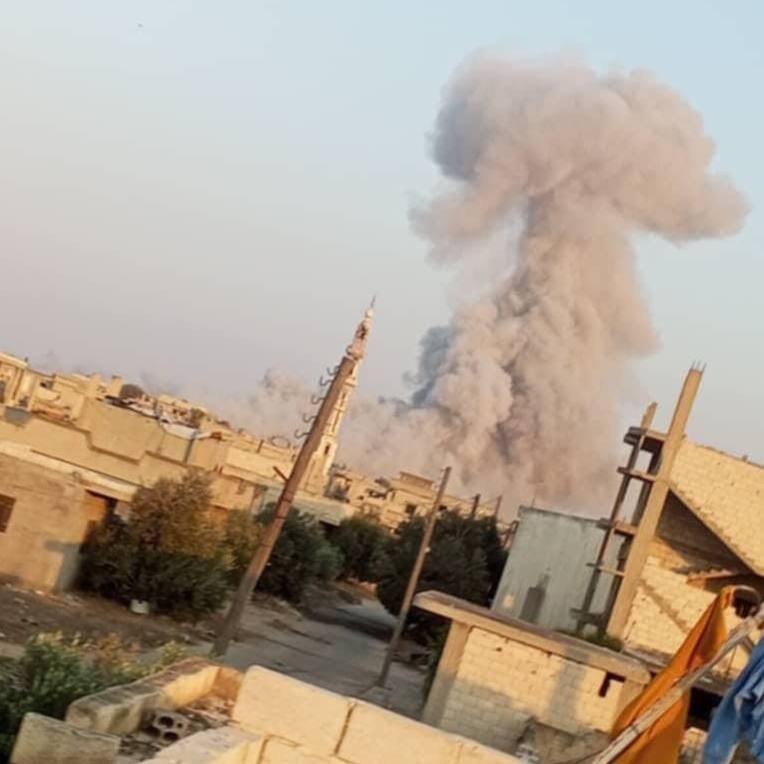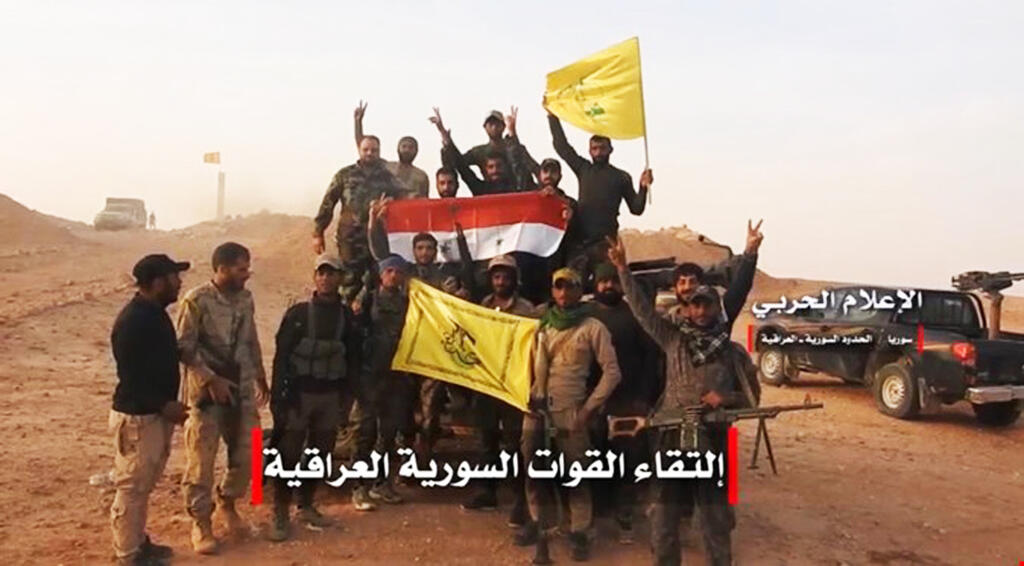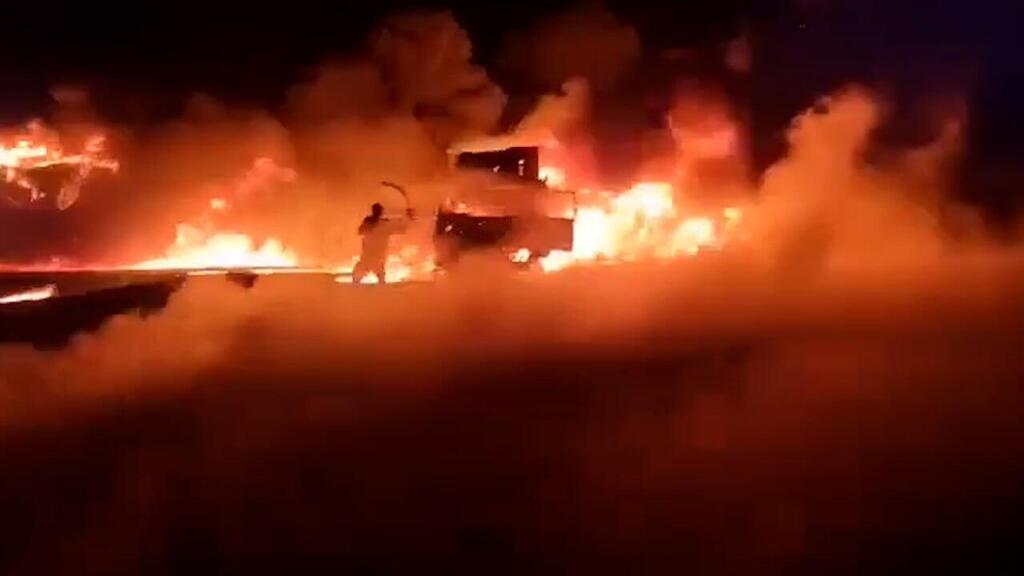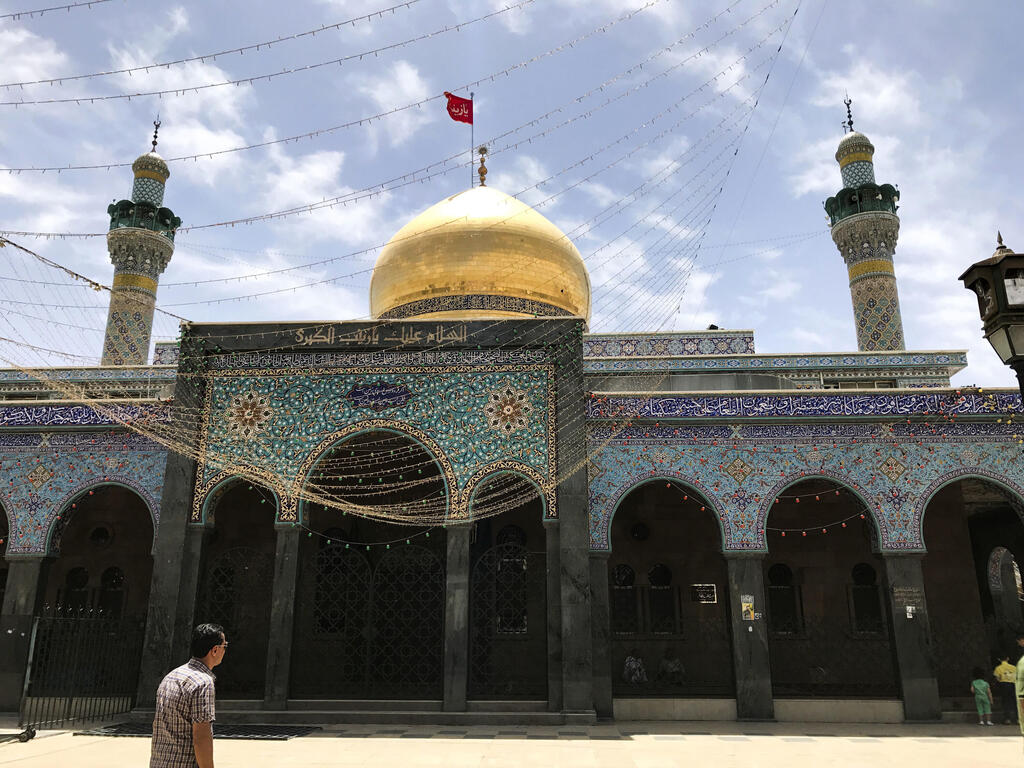Getting your Trinity Audio player ready...
“Those miscreants will destroy Syria and Lebanon. They’ve fallen into their own trap. They’ll be allowed to enter Al-Qusayr and wreak havoc wherever they can in Syria, only to be exhausted before being finally eliminated.” This is what Lieutenant General Hekmat Al-Shehabi, former chief of staff of the Syrian Army, told me about Hezbollah just before they occupied the city of Al-Qusayr.
Over the past month, a noticeable acceleration in Iranian tactics has become evident, as Iran has been shifting its assets across the region. Hezbollah, for example, has evacuated many of its bases in southern Syria near the Golan Heights. These bases have been taken over by Iraqi "Hashed Militias," whose members were granted Syrian citizenship by President Bashar al-Assad. They now wear the same military uniforms as the “Fourth Division,” a transparent and clumsy attempt at deception. This change occurred shortly after Israeli strikes on the villa of Maher al-Assad, leader of the Fourth Division, in Ya’afour, a western suburb of Damascus, at the end of last September. The attack was a clear Israeli message to Assad and his brother.
Over the past month, Syrian intelligence agencies have launched a disinformation campaign in Arab media, claiming that the leadership of the Fourth Division has ordered a halt to weapons transfers to Hezbollah and prohibited the accommodation of Iranian militants in its headquarters and bases. These fabricated claims appear to be a desperate attempt to avoid further Israeli strikes.
It is particularly striking that Hezbollah militants, who have retreated from southern Syria, southern Lebanon, the Bekaa Valley and the southern suburbs of Beirut, have relocated to Homs, Latakia and Tartus. Notably, significant public tension has emerged in Homs due to the large influx of Hezbollah militants into the city, alongside the deployment of Al-Fuhood militias, which are overseen by Syrian military intelligence and supported by Iran.
Latakia, Tartus, and particularly Al-Qardaha, have effectively transformed into militarized zones due to the heavy presence of Hezbollah forces. These militants have taken positions in secret tunnels and rocket-launching sites previously identified with the assistance of the Movement of Free Alawite Officers, which opposes Assad. Key locations include Beit Zantout, Al-Jofeah, Shiddaytah, Al-Maiseh and several other areas.
It is also noteworthy that these developments coincide with information I received from Al-Qardaha about 30 days ago. This intelligence suggests that the Iranian Revolutionary Guards have begun intensive dialogue sessions with hundreds of Alawite officers to mobilize them into working more closely with Iranian forces.
Meanwhile, over the past three weeks, tons of Captagon have been smuggled from various locations in Lebanon's Bekaa Valley, Hermel and Baalbek—areas previously targeted by Israeli strikes. These smuggled drugs have reportedly been hidden in multiple sites across the suburbs of Damascus, Daraa and Sweida.
One of the paradoxes in the Syrian scene is that the Iranian Revolutionary Guards have sent approximately 200 militants from the Polisario Front—supported by Algeria and Iran—to southern Syria. These militants have been deployed at the Al-Thaala military airport, an air defense base in Sweida, and the 90th Brigade, which is located only 20 kilometers (12 miles) from the Golan Heights. Notably, over the past three years, Iran has been training Polisario Front militants at Syrian Army bases in the countryside of Daraa.
The benefits Algeria might gain by supporting the Polisario Front’s unjustified antagonism against Morocco remain incomprehensible. Similarly, it is difficult to understand what Algeria hopes to achieve by backing Assad’s regime, aligning with Iran and supporting its unwarranted hostility toward the Syrian people. Why does Algeria permit Iranian penetration into its affairs and the buying of allegiance from certain Algerians? How does the Algerian regime tolerate insults to its sovereignty, such as when Iran threatened to block the Strait of Gibraltar? Are Algerians not aware of the threat posed by the Polisario Front to their national security now that it has become a tool of Iran, which trains and supports the group and dictates its actions?
In 2015, Algeria’s Al-Chorouk newspaper referred to me as a “mobile data bank” following an interview in which I discussed Islamist and terrorist organizations. During that interview, I warned of a potential war in Algeria, Iran’s suspicious activities in the country and the dangerous role played by Ameer Musawi, an officer in the Iranian Revolutionary Guards. However, Algerians were not fully aware of the looming threat. It has always been clear to me that wherever Iran intervenes, destruction and devastation are sure to follow.
The involvement of the Polisario Front in Syria underscores my call for the international community to classify this rogue organization as a terrorist entity. Today, the Polisario Front poses a real threat not only to the national and territorial sovereignty of Morocco but also to the stability of the entire region. Serious action must be taken to dismantle this group and hold accountable all parties involved in supporting and training it.
In Syria, Iran operates 63 militias and 82 military bases in the south of the country, as part of a broader network of 529 bases across Syria. These include 52 military bases and 477 military detachments distributed across 117 locations in Aleppo, 109 sites in the suburbs of Damascus, 77 locations in Deir ez-Zor, 67 in Homs, 28 in Hama, 27 in Idlib, 20 in Quneitra, 17 in Daraa, 14 in Raqqa, 13 in Sweida, 9 in Tartus, 8 in Al-Hasakah and 7 in Damascus.
To reinforce its military operations launched from Syrian and Iraqi territories, Iran has redeployed Hezbollah and its affiliated militias to extend the range of their operations and alleviate the military pressure on Hezbollah in Lebanon. Consequently, Hezbollah militants have tactically shifted their positions, relocating rockets, weapons and ammunition to other areas of Lebanon that were previously outside its control. This move aligns with a broader plan that risks plunging Lebanon into civil war—a scenario that is increasingly likely and alarmingly close to becoming a reality.
Following Israeli airstrikes targeting various areas in Bekaa, Hermel and Baalbek, weapon smuggling activity has been observed—not only within Lebanon but also across the border into Syrian territories. This smuggling occurs through the mountains, the Al-Zabadani crossing, Jusiyah and a network of tunnels along the Syria-Lebanon border, including a tunnel built by Hezbollah beneath the Al-Zabadani plains.
Recent Israeli airstrikes on Al-Qusayr, a long-standing hub for weapon storage and a key transit point for arms deliveries from the port of Latakia to Lebanon and other regions in Syria, have forced Iran to establish new warehouses in surrounding villages near Al-Qusayr.
Despite Hezbollah's diminished presence in the Al-Qalamoun area, including its towns, villages and some neighborhoods of Yabroud City, the group still controls strategic locations such as Talaet Musa Mountain, Syria's second-highest peak after Mount Hermon. It remains unclear whether the rocket-launching base in the Hermel mountains continues to operate.
Additionally, redeployment operations involving Iranian militias have been observed in Mayadeen and Al-Bukamal, cities located in Syria’s eastern Deir ez-Zor region.
In Damascus and its suburbs, many might be surprised to learn that Iran began working toward its dominance in the region as far back as 2003, coinciding with the arrival of Iraqi refugees to Syria. Many of these refugees were loyal to Iran. Since then, Iran has established warehouses for weapons, rockets and ammunition beneath the Sayyidah Zainab shrine in the southern suburbs of Damascus. This area has become strikingly similar to Beirut’s southern suburb in Lebanon—a military base hidden beneath a residential neighborhood.
Sayyidah Zainab is connected to nearby areas such as Najha, Aqraba, Bab Bila, Sbeneh, Sheba’a, Housh Plas and Ghuzlaniyah, extending to the old headquarters of Damascus Airport. This network of tunnels houses command centers, operations rooms and military warehouses for weapons, ammunition and rockets. Most of the residents in these areas are members of Iranian militias and their families.
Two key issues have drawn my attention while analyzing the Israeli strikes on various areas in Lebanon:
I. The quality of weapons used in the attacks, as shown by the Israeli military in videos displaying arms found in Hezbollah’s tunnels and hideouts in southern Lebanon, clearly indicates that these are the same weapons Hezbollah previously received from Assad’s regime.
In February 2012, I was one of the founders of the Joint Command of the Free Syrian Army inside Syria and served as its spokesman. The command was first established in the countryside of Homs, and my position gave me detailed knowledge of the situation and developments, including battles across Syria. During that time, we uncovered a meeting between Jabhat al-Nusra and Hezbollah in Baalbek, which I exposed to Lebanese media before Hezbollah looted the largest military warehouses of the Syrian Army in Maheen.
On October 21, 2013, Hezbollah, in collaboration with Jabhat al-Nusra and other military factions aligned with the Muslim Brotherhood, carried out the operation. They looted 32 warehouses containing 200 compartments. Each compartment held between 6 to 40 tons of weapons and ammunition.
Under the Assad regime's oversight, Hezbollah transported the contents of 200 trucks loaded with weapons, including 10,000 Grad rockets, 107 mm rockets, over 20,000 mortar shells of 120 mm caliber, 10,000 anti-tank missiles, 4,000 hand grenades, Thousands of 9M133 Kornet and 9M113 Konkurs anti-tank missiles, thousands of rocket-launching pads, landmines, thousands of AK-47 assault rifles and PKS machine guns, large quantities of ammunition, anti-aircraft machine guns of 23 mm and 14 mm caliber and numerous other types of weapons.
7 View gallery


Hezbollah weapons seized by the IDF in Lebanon
(Photo: Maya Alleruzzo/Associated Press)
7 View gallery


Hezbollah weapons seized by the IDF in Lebanon
(Photo: Maya Alleruzzo/Associated Press)
7 View gallery


Hezbollah weapons seized by the IDF in Lebanon
(Photo: Maya Alleruzzo/Associated Press)
II. On July 19, 2013, I revealed to the international media that Hezbollah had received two shipments of chemical weapons from Damascus, along with all the necessary mixing machines and production tools. These weapons were stored in four key locations in Lebanon, designated for Hezbollah’s strategic arsenal. Some of these sites have been targeted recently by the Israeli military. The locations are as follows:
- Warehouses and caves in the Al-Hermel forests, adjacent to the Akkar forests near Mechmech town. This site includes training centers and research laboratories staffed by Iranian experts and officers.
- Bases in Sannine Mountain, near Al-Matn in the direction of Bednayel town in the Bekaa region.
- Warehouses in Ouyoun Orghosh, located between Ainata, Al-Arz,and Bsharri. These facilities were established in 2012, turning the area into a military zone controlled by Hezbollah.
- Warehouses in the wilderness of Yammona, in the western part of Baalbek’s countryside. This area is also known for widespread cannabis cultivation.
All of Hezbollah’s military and strategic weapons warehouses are located in the western mountain range in central Lebanon. Due to their strategic importance, these sites remain on high alert for potential usage or redistribution to other locations as needed.
Hezbollah often creates a false impression that its military assets are concentrated in the eastern mountain range, drawing attention to areas such as Nabi Chit and Brital in Baalbek. However, this is a deliberate distraction. While these locations serve as important security zones and house some weapons, they do not contain Hezbollah’s most critical or strategic military stockpiles. The organization uses these eastern sites to divert attention from its primary arsenal hidden in the western mountain range.
Despite the dangers posed by Hezbollah’s reservoir of weapons, ammunition and rockets—and the fact that some of these military assets have been exposed by explosions in tunnels and warehouses under residential areas during Israeli airstrikes on southern Lebanon—Hezbollah continues to hide its arsenal in isolated wilderness areas and mountaintops far from inhabited zones. The organization deliberately conceals these weapons from public view and passersby.
Get the Ynetnews app on your smartphone: Google Play: https://bit.ly/4eJ37pE | Apple App Store: https://bit.ly/3ZL7iNv
Additionally, Hezbollah has banned grazing in areas near its strategic military stockpiles and heavily fortifies its bases from both security and military perspectives. Farmers are prohibited from accessing their fields near these sites, and even the Lebanese Army is barred from approaching or knowing the contents of these warehouses.
These military depots are located near towns and villages that serve as Hezbollah’s social strongholds, where local residents pledge full allegiance to the group.
 Fahad Almasri Photo: Courtesy
Fahad Almasri Photo: CourtesyIsrael has no viable alternative other than the full implementation of UN Resolution 1559, which calls for the disarmament of Hezbollah—not just in Lebanon but also in Syria—to eliminate threats to the security of Israel, its citizens and the broader region.
Without disarmament, this war will lack meaningful resolution. If the process is delayed or suspended, Hezbollah will rebuild its military capabilities, becoming more dangerous and hostile than ever. It will continue destabilizing Lebanon, Syria and the entire region.
Relying on the Lebanese Army to disarm Hezbollah is futile, as the army has been deeply infiltrated by Hezbollah and Iran since 2005, following the assassination of former prime minister Rafik Al-Hariri.
As Lebanon edges closer to civil war, the deployment of an international inspection team has become an urgent necessity. This team should be tasked with locating and dismantling all of Hezbollah’s military stockpiles. Additionally, the Syrian-Lebanese border, Lebanese airports, and Beirut’s seaport must come under the full control and supervision of NATO to ensure regional stability and security.
- Fahad Almasri is president of the National Salvation Front in Syria.






